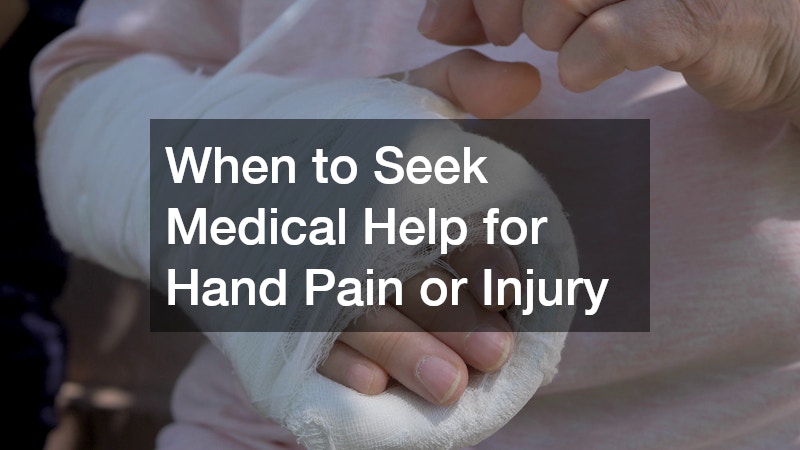
Hand pain or injuries can make even simple daily tasks, such as writing, typing, cooking, or lifting objects, painful or difficult. Knowing when to seek medical help is crucial to prevent long-term complications and ensure proper recovery. Hand pain can arise from repetitive strain, sudden trauma, or underlying health conditions like arthritis. Understanding the severity of symptoms and recognizing warning signs is essential in deciding when to consult a healthcare professional. This article explains common causes of hand pain, how to assess injury severity, when to consult specialists including hand surgeons, treatment options, and strategies for effective recovery. Taking prompt action can make a significant difference in restoring hand function and maintaining quality of life.
Common Causes of Hand Pain and Injury
Hand pain can stem from various causes. Repetitive strain injuries (RSIs) are common among individuals who frequently perform the same hand movements, such as typing, texting, or using tools. RSIs, including carpal tunnel syndrome and tendonitis, often develop gradually, causing numbness, tingling, and persistent discomfort. Ignoring these early warning signs can lead to worsening symptoms and long-term functional issues.
Traumatic injuries are another major cause of hand pain. Accidents, falls, or sudden impacts can lead to fractures, dislocations, or deep cuts. Symptoms such as severe pain, swelling, or visible deformities usually require immediate medical evaluation. Even minor injuries should be monitored to ensure they do not worsen or result in complications over time.
Underlying health conditions, including osteoarthritis and rheumatoid arthritis, can also lead to chronic hand pain. In these cases, inflammation and stiffness may gradually reduce mobility and affect the ability to perform daily tasks. Recognizing the source of hand pain—whether repetitive strain, trauma, or a medical condition—is essential for determining the appropriate treatment and whether specialist care is needed.
How to Assess the Severity of a Hand Injury
Knowing how to assess a hand injury’s severity is vital for determining whether professional care is needed. Certain red flags, such as severe pain, swelling, deformities, or inability to move fingers, indicate that immediate medical attention is required. Pain that persists beyond a few days, worsens over time, or recurs frequently should also prompt a consultation with a healthcare provider.
Self-assessment can help you gauge the situation before seeking professional care. Gently testing finger mobility, checking for differences in strength between hands, and noting swelling or bruising can provide insight into the extent of the injury. However, self-assessment is not a replacement for professional evaluation, especially if daily activities are affected. Timely assessment ensures that injuries do not worsen and that proper treatment begins promptly.
When to Consult a Specialist
Consulting a specialist, such as hand surgeons, becomes necessary when pain or injury persists despite initial care. Persistent swelling, stiffness, or discomfort that interferes with daily tasks is a strong indication to seek specialist evaluation. Hand surgeons have the expertise to diagnose and treat complex hand injuries, including tendon, ligament, or nerve damage, fractures, and severe arthritis-related conditions.
Sometimes, a general practitioner may refer patients to hand surgeons or rheumatologists if non-surgical treatments are insufficient or if a detailed evaluation is necessary. Loss of hand function, weakness, or reduced dexterity are all signals that specialist intervention may be required. Seeking care early often improves outcomes and prevents permanent loss of mobility or chronic pain.
Treatment Options for Hand Pain and Injuries
Treatment varies depending on the cause and severity of the injury. Non-surgical approaches are often the first line of care. Physical therapy, splints, anti-inflammatory medications, and activity modifications can alleviate symptoms and support recovery for minor injuries or repetitive strain conditions. Early intervention with conservative treatments often prevents the need for more invasive procedures.
In more severe cases, surgical intervention may be necessary. Hand surgeons perform surgeries to repair fractures, tendon or ligament injuries, and nerve compression, aiming to restore function, reduce pain, and prevent long-term disability. Rehabilitation following surgery is essential and often includes strength and flexibility exercises to restore full mobility. Preventative strategies, such as ergonomic adjustments and proper hand care routines, can further reduce the risk of re-injury and support long-term hand health.
Strategies for Effective Recovery
Effective recovery involves understanding the healing process and following medical guidance. Initially, rest and reducing inflammation are critical. As healing progresses, gradually incorporating exercises to regain strength, flexibility, and dexterity is important. Regular follow-up care with healthcare providers, including hand surgeons, ensures that progress is monitored and treatment plans are adjusted as needed.
Maintaining hand health in daily life is also crucial. Ergonomic workstations, stretching exercises, and mindful use of hands during repetitive tasks help prevent reinjury. Combining professional guidance with proactive hand care ensures better outcomes, reduces the risk of chronic pain, and allows individuals to maintain normal function and quality of life over the long term.
Promptly seeking medical help for hand pain or injury is essential for preventing further damage and ensuring effective recovery. Recognizing common causes, assessing the severity of injuries, consulting specialists when necessary, exploring treatment options, and following recovery strategies are all vital steps. Hand surgeons play a key role in diagnosing complex injuries, performing necessary interventions, and guiding rehabilitation. Taking timely action, adhering to professional recommendations, and incorporating preventive measures can restore hand function, reduce pain, and improve overall quality of life.

